Harley-Davidson’s Dyna lineup, known for its performance-oriented design and classic styling, has earned a mixed reputation over the years among riders. This range serves as a bridge between the brand’s larger touring bikes and the more nimble Sportster models. Collectors and enthusiasts often debate the best and worst years for Dyna models, primarily due to the brand’s history of engineering changes and updates that influenced reliability and performance.
When considering which Dyna models to purchase or avoid, potential buyers turn their attention to aspects such as the reliability of engines, build quality, and the overall riding experience. While certain years stand out for their robust design and dependability, others have been flagged for issues that may affect long-term satisfaction. Harley-Davidson has continuously evolved its manufacturing processes, and these changes are reflected in the varying levels of quality and performance seen through different model years.
Diligent research into the history of Dyna models reveals that certain years are more likely to provide riders with the balance of power, reliability, and the authentic Harley-Davidson experience they seek. Conversely, some periods are noted for models that may not meet the high expectations synonymous with the brand. It is through the examination of these variations that riders can make informed decisions about which Dyna motorcycles represent the best of what Harley-Davidson has to offer and which ones to potentially avoid.
Related reads:
– Dyna vs FXR: Historic Harley Model Showdown and Comparison
– Harley Model Showdown: FXR vs FXRS vs FXRT
History and Evolution of Dyna Models
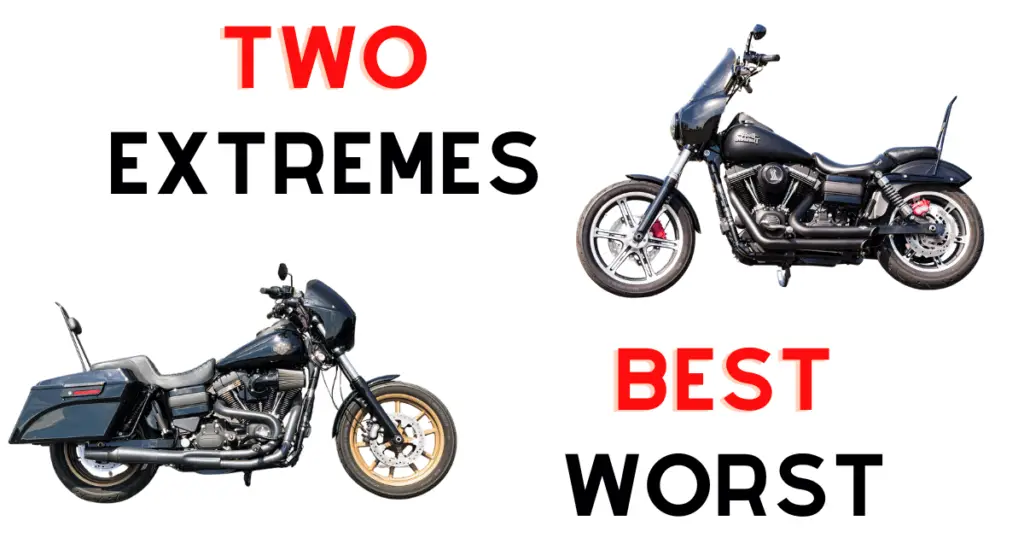
The Harley-Davidson Dyna lineup is known for its significant contributions to motorcycle engineering and design. From its inception, through engine transitions, to its role in the Harley-Davidson range, the Dyna series has evolved to meet the demands of riders and the marketplace.
Inception and Early Years
The Dyna line was officially introduced by Harley-Davidson in 1991 with the FXDB Sturgis model. Its history, however, traces back to the preceding FXR models, which began in 1982, originating with the frame that would later influence the Dyna chassis. The initial Dyna models utilized the Evo engines, also known as Evolution engines, which provided an upgrade in power and reliability compared to the older Shovelhead engines.
Transition to Twin Cam Engines
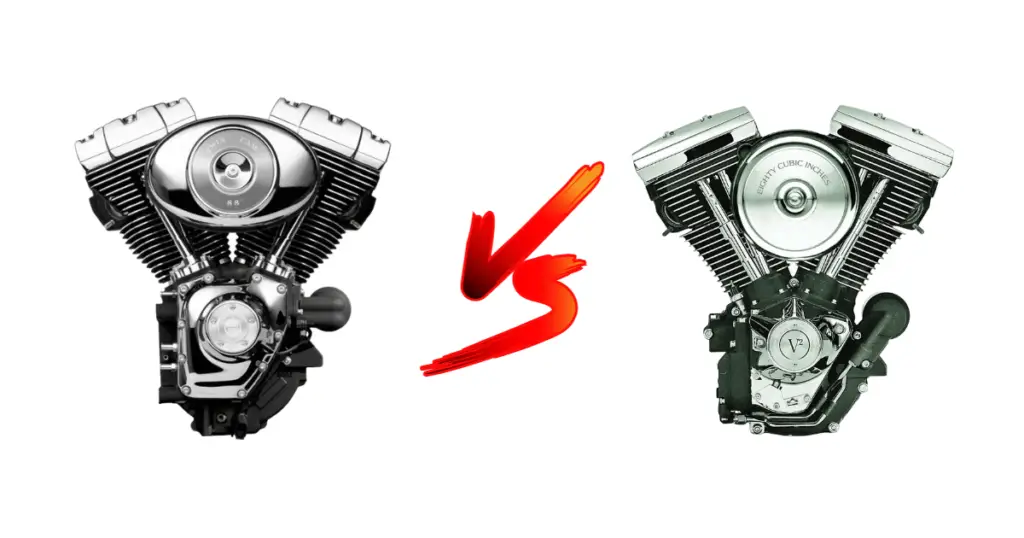
In 1999, Harley-Davidson began fitting Dyna models with the Twin Cam engine, marking a significant advancement in the series’ performance capabilities. The Twin Cam engine offered increased displacement and improved engine mounting systems, refining the overall riding experience.
Dyna’s Position in Harley-Davidson Lineup
Dyna has held a special place within the Harley-Davidson lineup, offering a bridge between their traditional, larger-frame touring bikes and the sportier, lighter Sportster. By providing a middle ground, Dyna models appealed to those seeking both a big-twin engine feel in a leaner package. Over their production years, these motorcycles became known for balance in aesthetics and performance.
Engine Specifications and Performance
The Harley-Davidson Dyna series is known for its robust Twin Cam engines, offering an impressive combination of power and efficiency. The engines in this lineup have undergone various updates to improve performance and reliability.
Overview of Twin Cam Engine
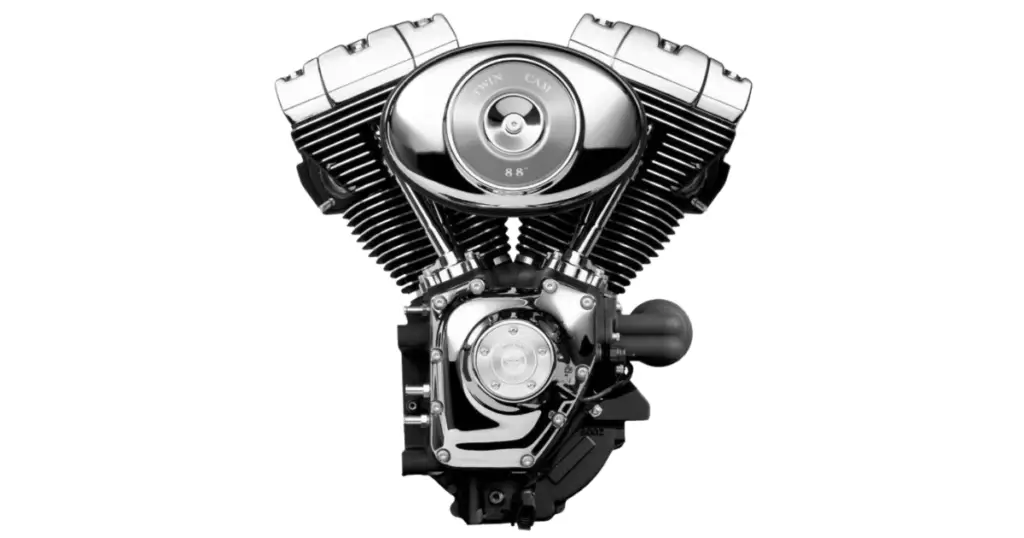
The Twin Cam engine, also known as the Harley Twin Cam, is the successor to the original Harley-Davidson Evolution engine. Initially introduced in 1998, it has been a key feature in the Dyna series until the model was discontinued in 2018. The Twin Cam is known for its air-cooled feature, overhead valve, and twin camshaft design. Throughout its evolution, it was offered in multiple displacements, ranging from 88 cubic inches (1,450 cc) to 110 cubic inches (1,801 cc).
Comparison With Other Harley Engines
When compared to its predecessors, the Twin Cam engine provided a significant upgrade in terms of power and smoothness. The introduction of fuel injection (EFI) in later models allowed for a more efficient fuel delivery, translating to better throttle response and overall performance. Additionally, the Twin Cam incorporated a more advanced oil pump system than the Evolution engine, resulting in improved reliability and longevity of the engine.
Performance Upgrades and Modifications
Owners of Dyna motorcycles have a variety of options when it comes to performance upgrades and modifications for the Twin Cam engine. These can include:
- Stage upgrades: Ranging from Stage I to Stage IV, each level offers increased improvements in performance, from air intake and exhaust modifications to full engine rebuilds with increased displacement.
- Tuning: Utilizing aftermarket tuners to adjust the fuel and ignition curve for better performance.
- Air-cooled enhancements: Upgrades like oil coolers and more efficient fans to manage engine temperature more effectively.
The choices for modifications allow enthusiasts to tailor their bike’s performance to their liking, whether they aim for a smoother ride or seeking higher horsepower and torque figures.
Notable Dyna Models and Their Legacy
The Harley-Davidson Dyna series has made a significant mark in the motorcycle community with its array of models that cater to various tastes and preferences. Each model in this series has contributed to the Dyna’s enduring legacy.
Significant Models Throughout the Best Dyna Years
- Dyna Super Glide (FXD): Introduced as part of the 1995 lineup, the FXD Dyna Super Glide became a popular choice for its simplicity and performance. It featured a 28° rake, differing from the earlier 32° rake on previous models.
- Dyna Wide Glide (FXDWG): Recognizable for its wider front fork, the Dyna Wide Glide offered a distinct visual appeal and was favored for its comfortable ride and classic design (However there were some occasional issues encountered in some models).
- Low Rider (FXDL): The Dyna Low Rider, through its various iterations, has been synonymous with custom styling and accessibility. Its lower seat height and adjustable suspension have made it a preferred option among riders.
- Fat Bob (FXDF): As a more recent addition, the Fat Bob brought a massive front tire, aggressive stance, and performance-oriented features that appealed to a modern rider demographic.
- Street Bob (FXDB): Known for its stripped-down aesthetic, the Street Bob gave riders a minimalist platform that was ripe for customization.
Special Editions and Collectibles
- FXDX (Dyna Super Glide Sport): The Super Glide Sport garnered a following for its enhanced performance capabilities, such as improved suspension and dual disc front brakes, making it a collectible.
- FXSTB Night Train: Although not a Dyna but a Softail model, the Night Train’s unique styling and “blacked-out” theme left a lasting impression that makes it a sought-after bike among enthusiasts.
- Low Rider S (FXDLS): The Low Rider S was a high-performance variant that Cycle World named its best cruiser for the year 2017, cementing its status as a notable collectible within the Dyna line.
- Softail Deluxe: Transitioning the Deluxe to the Softail line reflected Harley-Davidson’s move to phase out the Dyna in favor of a unified Softail chassis with Dyna-inspired aesthetics.
In the shifting landscape of Harley-Davidson’s model lineup, the Dyna series stands as a testament to the brand’s capacity to blend tradition with innovation.
Key Technical Issues and Worst Dyna Years to Avoid
The Dyna series has been popular among riders for its performance and style. However, specific years have been noted for their technical issues, leading to higher maintenance needs and potential safety concerns.
Cam Chain Tensioner Problems
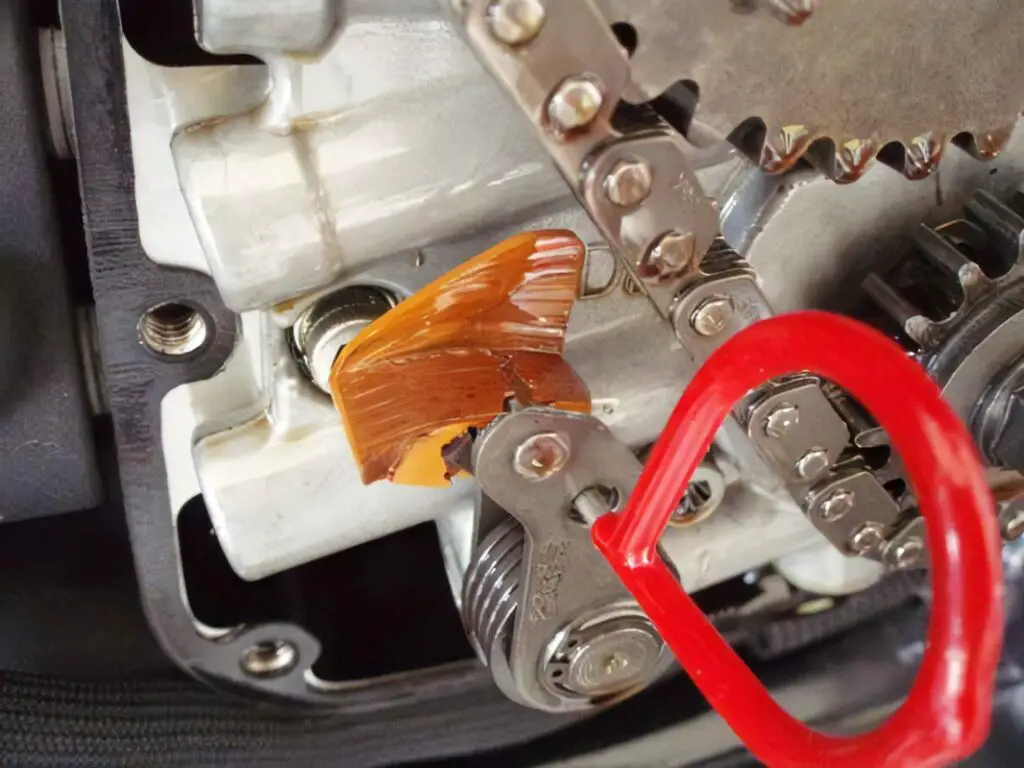
Years to Avoid: 1999-2005
Issues: The Twin Cam engines that were introduced from 1999 are especially prone to failure of the cam chain tensioners. The tensioners could wear out prematurely, leading to potential engine damage.
- Models Affected: Includes a range of models like the Dyna with Twin Cam engines during these years.
Maintenance Challenges with Specific Models
Years to Avoid: 2006 (Transition Year)
Technical Issue:
- Cam Chain Tensioner and Inner Primary Bearing: These parts had notable issues in 2006, creating maintenance challenges for owners.
- High Crank Runout: This issue was prominent in certain models, affecting engine stability.
Recalls and Quality Control Concerns
Years with Notable Recalls:
- 2008: Faulty master cylinders led to recall due to the risk of brake failure.
- Various Years: Other sporadic quality control concerns led to recalls over the years.
Quality Control:
- Ensuring components such as cam chain tensioners were checked and maintained became crucial due to these concerns.
General Advice:
- Prospective buyers are advised to thoroughly check the maintenance and recall history of any used Harley-Davidson Dyna model.
Dyna Models’ Performance on the Road
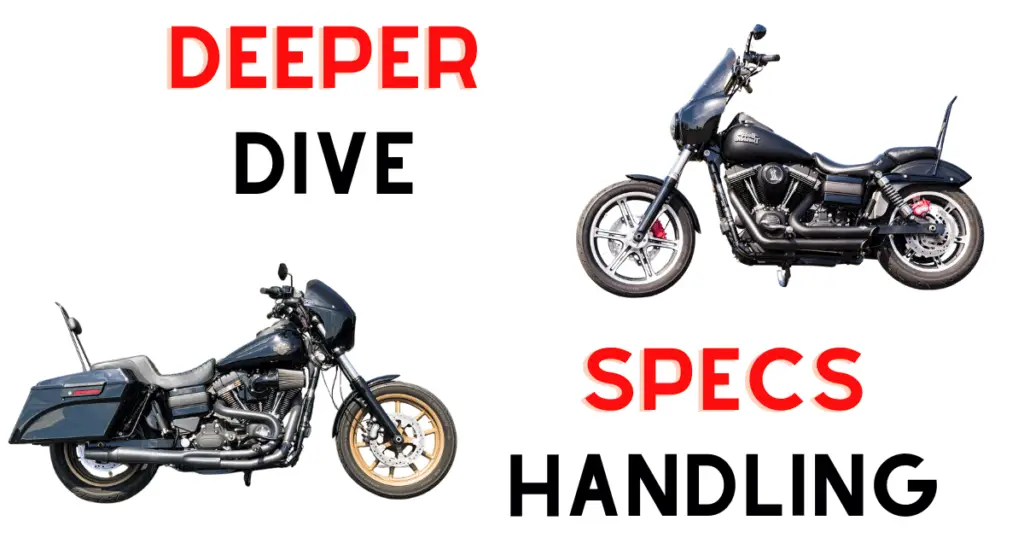
When examining Dyna motorcycles, their on-road performance can primarily be assessed through their handling, braking, and drivetrain systems. These bikes have been designed to provide a balanced riding experience, with considerations for comfort during long rides and responsiveness in varied conditions.
Handling and Ride Quality
Dyna models are known for a stable and smooth ride, making them a popular choice for riders who seek comfort without sacrificing the ability to manage tight turns with precision. They notably feature a big-twin engine that contributes to their low-end torque and better balance at low speeds. Over the years, riders have reported that the weight distribution of Dynas contributes positively to their handling, particularly in the case of models like the Dyna Fat Bob.
Braking and Suspension Systems
The braking system on Dyna models has evolved, with later models featuring more advanced and reliable brakes for shorter stopping distances and improved safety. The suspension, an essential aspect for any motorcycle, greatly contributes to Dynas’ enjoyable riding experience. The suspension system, often including adjustable rear shocks, has been noted for its ability to absorb bumps, providing a cushioned ride which is particularly appreciated on less-than-perfect road surfaces.
Gearbox and Drivetrain Evaluation
Dyna motorcycles come equipped with a gearbox that offers a smooth transition between gears. The integration of a 6-speed transmission in later years has been a welcome upgrade, providing riders with better fuel efficiency and a more relaxed highway cruising experience. The drivetrain of a Dyna is designed to be strong and reliable, contributing to the overall riding experience and ensuring riders can enjoy both city commutes and longer journeys with confidence.
Comparative Analysis: Dyna Versus Softail
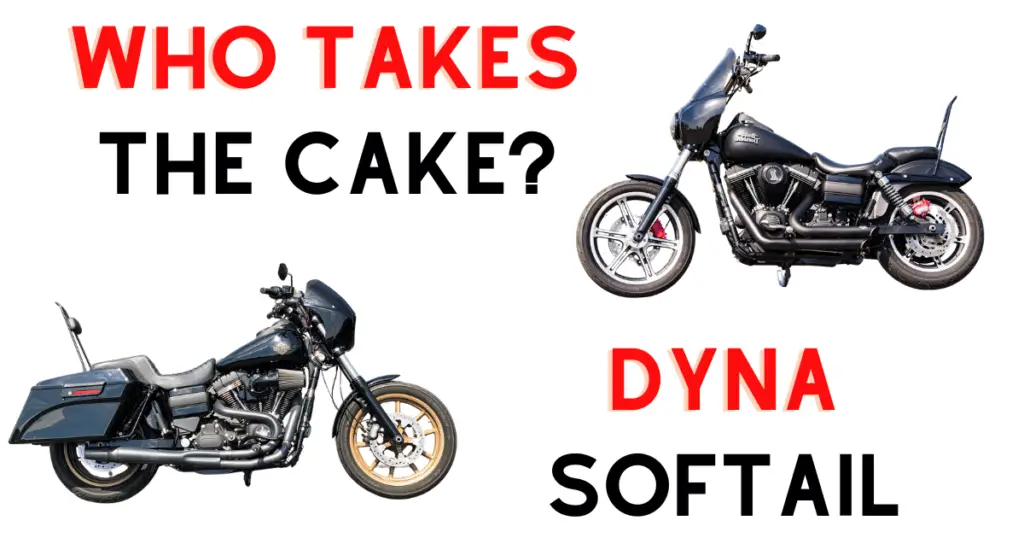
This section examines contrasts between Dyna and Softail, focusing on design, performance, and their reception in the motorcycle market.
Design Philosophies and Rider Appeal
The Dyna and Softail models by Harley-Davidson encapsulate distinct design philosophies. Dyna motorcycles are recognized for a traditional frame and rubber-mounted engines, aiming for a classic riding experience. They typically feature a dual-shock rear suspension system, giving them a characteristic profile. In contrast, the Softail line conceals its rear shocks, emulating a hardtail look while providing a smoother ride. This design appeals to riders seeking vintage aesthetics without compromising on comfort.
Performance Metrics and Comfort
Performance is a noteworthy differentiator:
Dyna:
- Engine: High Output Twin Cam 103
- Transmission: 6-speed
- Suspension: Stiffer, “sportier” feel
Softail:
- Engine: Milwaukee Eight 107 V-twin
- Transmission: 6-speed
- Suspension: Softer, more comfortable ride experience
The Dyna models deliver more torque, offering a rawer and responsive ride. The Softail lineup, however, is noted for its balanced performance, with a whisper of additional torque provided by the Milwaukee Eight engine. As for reliability, both lines typically embody Harley-Davidson’s standards, but individual model years may vary in durability and required maintenance.
Market Position and Consumer Choices
Both Dyna and Softail motorcycles cater to distinct segments of the market. The Dyna is often pitched towards enthusiasts of the traditional Harley feel, those who prefer agility and a visceral riding connection. The Softail lineup caters to riders aiming for cruising comfort without sacrificing the classic Harley aura. Consumer choices often hinge on these preferences, with the Softail presently being more ubiquitous following the discontinuation of the Dyna line in 2017. However, certain Dyna models, thanks to their cult following, continue to sustain a robust secondary market.
Owner Experiences and Community
The Harley-Davidson Dyna series commands a dedicated following, with riders often sharing their experiences and emphasizing the Dyna’s role within the broader motorcycle community.
Loyal Fan Base and Owner Reviews
Harley-Davidson motorcycles, particularly the Dyna model, have cultivated a loyal fan base consisting of people who not only ride but also live the brand. Owner reviews typically reflect a deep-seated appreciation for the brand’s heritage and the distinct character of each motorcycle. Positive attributes frequently highlighted include the Dyna’s big-twin engine and its versatile performance. Critics among the community, however, point out certain years with known issues—particularly the 2006 Dyna model, which had fuel tank problems, and the 2007 model with its transmission glitches.
Motorcycle Enthusiast Clubs and Events
Motorcycle enthusiast clubs and events form the backbone of the Harley-Davidson rider community. These groups provide a space for owners to share their passion, knowledge, and experiences. Events ranging from local meet-ups to larger gatherings like Sturgis attract Dyna riders who display their bikes, discuss modifications, and develop the camaraderie that is integral to the brand’s culture.
Aftermarket Support and Customization
The Dyna series is known for its customization potential, with a wide range of aftermarket parts available to enhance both performance and aesthetics. Enthusiasts often personalize their bikes with chrome accessories, performance equipment, and unique paintwork. The availability of these parts helps riders create a motorcycle that is truly their own—supporting a rich tradition of customization that has been synonymous with Harley-Davidson motorcycles for decades.
Advice for Prospective Buyers
When searching for a used Dyna model, prospective buyers should prioritize maintenance history, seek models known for reliability, and avoid those with a reputation for technical issues or poor design.
What to Look for in a Used Dyna
When considering a used Dyna, a buyer should examine the maintenance records closely, as a well-maintained motorcycle often indicates a lower risk of future technical issues. They should seek out models lauded by experts for their build quality and known to have fewer design flaws. A thorough inspection should be conducted for signs of wear and tear and any aftermarket modifications, which could influence the bike’s performance and reliability.
- Maintenance Records: Check for regular servicing and part replacements.
- Build Quality: Opt for models with a solid reputation.
- Wear and Tear: Inspect for excessive damage that goes beyond normal use.
- Aftermarket Parts: Assess any modifications to ensure they enhance the motorcycle’s performance rather than introduce potential problems.
Avoiding Common Pitfalls
Prospective buyers must be aware of certain years that may be associated with technical issues or recall actions due to poor design. It is essential to research specific Dyna model years and variants and to consult with industry experts about common problems associated with particular models.
- Recalled Models: They should avoid models with significant recalls or noted safety concerns.
- Expert Opinions: Consulting motorcycle forums, mechanic shops, and trusted reviews can provide insights into which models to consider or sidestep.
Making an Informed Purchase Decision
An informed decision involves not only knowing the Dyna’s history but also understanding the availability of parts and maintenance support. Buyers should consider if the Dyna they are interested in can be easily serviced and if parts are readily available, as this could affect long-term ownership costs and the motorcycle’s uptime.
- Parts Availability: Confirm the ease of sourcing replacement parts.
- Maintenance Support: Ensure there are knowledgeable mechanics or dealers capable of servicing the model in question.
Future of the Dyna Series
The Harley-Davidson Dyna series, a line of motorcycles revered for their performance and traditional styling, ceased production in 2017. This move by the motorcycle manufacturer marks a significant shift in their lineup strategy.
Expectations and Anticipations
It is anticipated that the discontinuation of the Dyna series will lead to increased collector interest in these models. Enthusiasts expect that the value of well-maintained Dyna motorcycles may appreciate over time due to their enduring popularity and historical significance in the Harley-Davidson lineup. However, no new models will be released under the Dyna name post-2017, as Harley-Davidson has decided to merge this series with the Softail line to streamline their offerings.
Impact on the Harley Brand and Lineup
Harley-Davidson’s decision to discontinue the Dyna series and merge it with the Softail line represents a strategic shift for the brand, emphasizing the importance of modernizing their lineup while maintaining their heritage aesthetic. The integration of Dyna’s characteristics into the Softail series is expected to enhance the brand’s portfolio with motorcycles that offer the performance of a Dyna coupled with a classic look, potentially appealing to both Dyna enthusiasts and new customers.